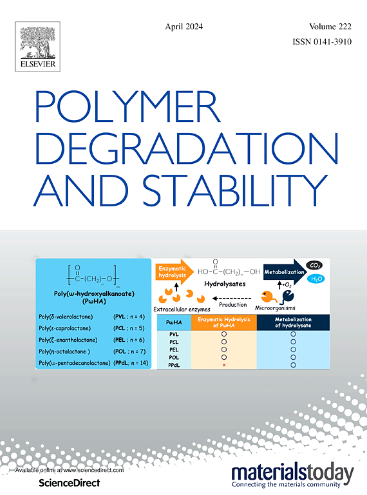通过刚性链段和石墨烯微粒的协调提高可回收聚脲的性能
IF 6.3
2区 化学
Q1 POLYMER SCIENCE
引用次数: 0
摘要
为响应全球对环境保护和可持续发展实践的关注,开发具有可回收和愈合特性的纳米复合材料对于实现高性能和长寿命结构是必不可少的。本研究提出了一种简便的方法来开发具有高机械性能的可回收和热诱导愈合聚脲(PU)/石墨烯小板(GNP)纳米复合材料。采用异佛尔酮二胺(IPDA)作为具有刚性环状结构的扩链剂,合成方法简单直接。在将 GNP 加入聚氨酯之前,先用 IPDA 对其进行改性,从而显著提高了其机械性能。当 GNPs 的重量百分比为 0.10 时,聚氨酯纳米复合材料的机械性能达到最高,改性 GNPs(M-GNPs)的性能明显优于原始 GNPs。具体而言,M-GNPs 使聚氨酯的拉伸强度提高了 41.3%,而原始 GNPs 仅提高了 12%,这突出表明了改性增强相的关键作用。此外,纳米复合材料还表现出了出色的愈合能力,在 120 °C 下放置 24 小时后,愈合效率达到 89%。此外,与纯聚氨酯相比,聚氨酯/M-GNP 纳米复合材料对酸性和碱性环境的耐受性更强。这项研究不仅是开发高强度环保材料的典范,而且有望在航空航天、减震和防护涂层等领域得到广泛应用。本文章由计算机程序翻译,如有差异,请以英文原文为准。
Enhancing the performance of recyclable polyurea through coordination of rigid chain segments and graphene platelets
In response to the global focus on environmental preservation and sustainable practices, developing nanocomposites featuring recyclable and healing properties is indispensable for high-performance and long-life structures. This study presents a facile approach to develop a recyclable and thermally-induced healing polyurea (PU)/graphene platelet (GNP) nanocomposites with high mechanical properties. A straightforward synthesis method was employed using isophorone diamine (IPDA) as chain extender with rigid cyclic structure. GNPs were modified with IPDA before adding into PU, showing remarkable enhancements in mechanical performance. At 0.10 wt.% GNPs, PU nanocomposites exhibited the maximum mechanical properties, with modified GNPs (M-GNPs) significantly outperforming pristine GNPs. Specifically, the tensile strength of PU increased by 41.3 % with M-GNPs, compared to only 12 % with pristine GNPs, underscoring the critical role of modifying the reinforcing phase. Furthermore, the nanocomposites demonstrated outstanding healing capabilities, achieving 89 % healing efficiency after 24 h at 120 °C. In addition, PU/M-GNP nanocomposites showed exceptional resistance to acidic and alkaline environments in comparison to neat PU. The study not only exemplifies developing high-strength and environmentally friendly materials but also holds promise for diverse applications, including aerospace, vibration damping, and protective coatings.
求助全文
通过发布文献求助,成功后即可免费获取论文全文。
去求助
来源期刊

Polymer Degradation and Stability
化学-高分子科学
CiteScore
10.10
自引率
10.20%
发文量
325
审稿时长
23 days
期刊介绍:
Polymer Degradation and Stability deals with the degradation reactions and their control which are a major preoccupation of practitioners of the many and diverse aspects of modern polymer technology.
Deteriorative reactions occur during processing, when polymers are subjected to heat, oxygen and mechanical stress, and during the useful life of the materials when oxygen and sunlight are the most important degradative agencies. In more specialised applications, degradation may be induced by high energy radiation, ozone, atmospheric pollutants, mechanical stress, biological action, hydrolysis and many other influences. The mechanisms of these reactions and stabilisation processes must be understood if the technology and application of polymers are to continue to advance. The reporting of investigations of this kind is therefore a major function of this journal.
However there are also new developments in polymer technology in which degradation processes find positive applications. For example, photodegradable plastics are now available, the recycling of polymeric products will become increasingly important, degradation and combustion studies are involved in the definition of the fire hazards which are associated with polymeric materials and the microelectronics industry is vitally dependent upon polymer degradation in the manufacture of its circuitry. Polymer properties may also be improved by processes like curing and grafting, the chemistry of which can be closely related to that which causes physical deterioration in other circumstances.
 求助内容:
求助内容: 应助结果提醒方式:
应助结果提醒方式:


